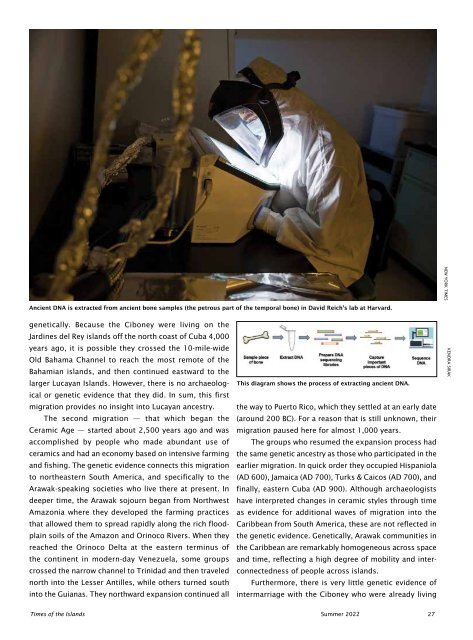Times of the Islands Summer 2022
Presents the "soul of the Turks & Caicos Islands" with in-depth features about local people, culture, history, environment, real estate, businesses, resorts, restaurants and activities.
Presents the "soul of the Turks & Caicos Islands" with in-depth features about local people, culture, history, environment, real estate, businesses, resorts, restaurants and activities.
Create successful ePaper yourself
Turn your PDF publications into a flip-book with our unique Google optimized e-Paper software.
NEW YORK TIMES<br />
Ancient DNA is extracted from ancient bone samples (<strong>the</strong> petrous part <strong>of</strong> <strong>the</strong> temporal bone) in David Reich’s lab at Harvard.<br />
genetically. Because <strong>the</strong> Ciboney were living on <strong>the</strong><br />
Jardines del Rey islands <strong>of</strong>f <strong>the</strong> north coast <strong>of</strong> Cuba 4,000<br />
years ago, it is possible <strong>the</strong>y crossed <strong>the</strong> 10-mile-wide<br />
Old Bahama Channel to reach <strong>the</strong> most remote <strong>of</strong> <strong>the</strong><br />
Bahamian islands, and <strong>the</strong>n continued eastward to <strong>the</strong><br />
larger Lucayan <strong>Islands</strong>. However, <strong>the</strong>re is no archaeological<br />
or genetic evidence that <strong>the</strong>y did. In sum, this first<br />
migration provides no insight into Lucayan ancestry.<br />
The second migration — that which began <strong>the</strong><br />
Ceramic Age — started about 2,500 years ago and was<br />
accomplished by people who made abundant use <strong>of</strong><br />
ceramics and had an economy based on intensive farming<br />
and fishing. The genetic evidence connects this migration<br />
to nor<strong>the</strong>astern South America, and specifically to <strong>the</strong><br />
Arawak-speaking societies who live <strong>the</strong>re at present. In<br />
deeper time, <strong>the</strong> Arawak sojourn began from Northwest<br />
Amazonia where <strong>the</strong>y developed <strong>the</strong> farming practices<br />
that allowed <strong>the</strong>m to spread rapidly along <strong>the</strong> rich floodplain<br />
soils <strong>of</strong> <strong>the</strong> Amazon and Orinoco Rivers. When <strong>the</strong>y<br />
reached <strong>the</strong> Orinoco Delta at <strong>the</strong> eastern terminus <strong>of</strong><br />
<strong>the</strong> continent in modern-day Venezuela, some groups<br />
crossed <strong>the</strong> narrow channel to Trinidad and <strong>the</strong>n traveled<br />
north into <strong>the</strong> Lesser Antilles, while o<strong>the</strong>rs turned south<br />
into <strong>the</strong> Guianas. They northward expansion continued all<br />
This diagram shows <strong>the</strong> process <strong>of</strong> extracting ancient DNA.<br />
<strong>the</strong> way to Puerto Rico, which <strong>the</strong>y settled at an early date<br />
(around 200 BC). For a reason that is still unknown, <strong>the</strong>ir<br />
migration paused here for almost 1,000 years.<br />
The groups who resumed <strong>the</strong> expansion process had<br />
<strong>the</strong> same genetic ancestry as those who participated in <strong>the</strong><br />
earlier migration. In quick order <strong>the</strong>y occupied Hispaniola<br />
(AD 600), Jamaica (AD 700), Turks & Caicos (AD 700), and<br />
finally, eastern Cuba (AD 900). Although archaeologists<br />
have interpreted changes in ceramic styles through time<br />
as evidence for additional waves <strong>of</strong> migration into <strong>the</strong><br />
Caribbean from South America, <strong>the</strong>se are not reflected in<br />
<strong>the</strong> genetic evidence. Genetically, Arawak communities in<br />
<strong>the</strong> Caribbean are remarkably homogeneous across space<br />
and time, reflecting a high degree <strong>of</strong> mobility and interconnectedness<br />
<strong>of</strong> people across islands.<br />
Fur<strong>the</strong>rmore, <strong>the</strong>re is very little genetic evidence <strong>of</strong><br />
intermarriage with <strong>the</strong> Ciboney who were already living<br />
KENDRA SIRAK<br />
<strong>Times</strong> <strong>of</strong> <strong>the</strong> <strong>Islands</strong> <strong>Summer</strong> <strong>2022</strong> 27
















